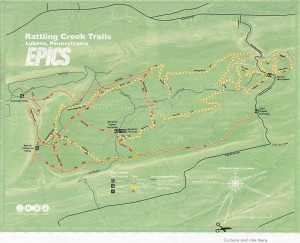IMBA’S MAPPING SPECIALIST VISITS PENNSYLVANIA
IMBA Mapping Specialist Leslie Kehmeier has been busier than a one-armed paper-hanger laying the groundwork for IMBA’s mapping program. Launching this type of venture is no small task, but one that will provide valuable resources for IMBA’s grassroots network in the years to come.
In addition to a vast amount of planning and research, Kehmeier has spent time in the field mapping selected trail systems in different regions. During those efforts, she’s had the opportunity to work with local chapters and advocates collecting information, refining techniques and developing the process for acquiring data on the ground.
“Our volunteer network will be a key aspect in building a comprehensive trails database. The knowledge they
can provide about their local trail systems is invaluable and we look forward to working with them as the mapping program continues to grow,” says Kehmeier.
In March, Kehmeier traveled to Lykens, Pennsylvania, home of the Rattling Creek Trails that were designated as an IMBA Epic in 2011. Until recently, this exceptionally well-designed and built trail system has remained largely unknown. Alongside local rider Mike Kuhn and Mid-Atlantic Region Director Frank Maguire, Kehmeier collected GPS data for the entire trail system and facilities, resulting in the map on these pages.
In upcoming weeks and months, IMBA will release a small sampling of additional Epics maps. But there’s much more to come with IMBA’s mapping program.
For advocacy work, maps provide an effective way to communicate with local land managers and decision makers. Maps can showcase the need to develop trail maintenance plans, inform public comment for protecting trails and help plan routes for future riding opportunities. In the near future, IMBA’s network of chapters, members and supporters will have access to a robust set of GIS and mapping tools to help them create great maps in their own areas and trail systems. Kehmeier will conduct trainings and help our grassroots network create customized maps that suit their local needs.
In Lykens, as with many communities, trail systems have proven to be a powerful economic driver. The new Rattling Creek Trails map will be used for more than just a navigational guide. The local city council is leading the charge to develop more trail opportunities in the area, including a rail trail. The map will become a useful tool in future fundraising campaigns and grant cycles and will illustrate the potential for trail opportunities and connections in the area. A picture is worth a thousand words, but a map could be worth thousands of dollars.
Mapping a trail system on a mountain bike is a challenge, but if you do it right the results will be worthwhile. Keep in mind the more comprehensive the acquisition effort, the more potential it has to generate different maps. This data I collected for this Rattling Creek map can be spun into other versions that highlight needs like trail maintenance or funding requests.
Once in the field, try to be patient — you won’t set any ride-time records while gathering trail data. Be ready for the process to require multiple days, frequent stops and constant backtracking. Be sure to focus on the components of the trail system and its supporting facilities, like trailheads and parking lots. Remember to capture points for notable bike-specific features like rock gardens, switchbacks and ladder bridges. I like to jot down lots of notes in the field that I can refer back to when I’m drafting a map on my computer screen.
It’s usually possible to acquire existing map data that covers vegetation, waterways and road systems, so those things shouldn’t be the focus of your field mapping efforts. Consider rounding out your documentation by capturing photos, videos and other materials that you might use to create a memorable, multi-media map for online presentations. When you assemble all the elements you’ll have a map that truly tells a story.
— Leslie Kehmeier, IMBA mapping specialist
The Rattling Creek Epic offers flowy trails punctuated with rock gardens, creating classic East Coast riding that rewards bike handling as much as fitness. Trails don’t get more sustainable than the Rocks Ridge section — a 3/4-mile boulder field that’s featured on the IMBA website under the heading “Toughen Your Trail With Rocks.” Unforgiving, yes. But it’s rideable if you’ve got the chops. More info at imba.com/epics.
Copied from IMBA Trail News, Summer 2012





